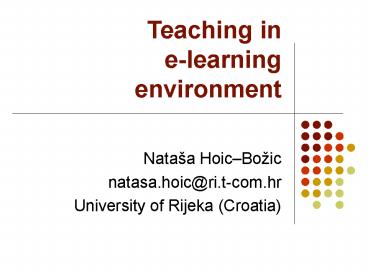Teaching in e-learning environment - PowerPoint PPT Presentation
Title:
Teaching in e-learning environment
Description:
Teaching in e-learning environment Nata a Hoi Bo i natasa.hoic_at_ri.t-com.hr University of Rijeka (Croatia) Agenda Introduction: What is e-learning? – PowerPoint PPT presentation
Number of Views:249
Avg rating:3.0/5.0
Title: Teaching in e-learning environment
1
Teaching in e-learning environment
- Nataša HoicBožic
- natasa.hoic_at_ri.t-com.hr
- University of Rijeka (Croatia)
2
Agenda
- Introduction What is e-learning?
- Major characteristic, technology, benefits,
drawbacks - Models of online learning and blended learning
- Role and activities of online teacher
3
E-learning term
- The "e-" prefix electronic
- e-business, e-commerce, e-banking, e-government,
e-marketing, - e-school, e-university, e-campus, e-library,
- e-teacher, e-student
- e-learning both learning and teaching
- Learning - the process of acquiring knowledge or
skill through study, experience or teaching
4
What is e-learning?
- Different definitions of e-learning
- Technology-oriented - emphasis is on e-
- E-learning is any kind of learning, training or
education that is enhanced by the use of
information and communication technologies
(ICT). - Pedagogical-oriented- emphasis is on learning
- E-learning is an interactive process between
teacher and the learner through the electronic
media.
5
E-learning continuum
- E-learning as a continuum of teaching
Source CARNet E-Learning Academy - ELA learning
materials
6
E-learning and technology
Form Description Technology
Traditional (f2f) teaching Teaching (mostly lecturing) in the classroom No technology
Classroom aids Technology is used to enhance the face-to-face teaching Presentations, multimedia CD-ROM, Web sites, online testing, e-mail, forum,
Mixed-mode A combination of face-to-face and technology- mediated teaching LMS (Learning Management System), videoconference
Online education Fully online e-learning in which all teaching is technology-mediated without any f2f meetings Courses are delivered on Internet (Web sites or LMS), videoconference
7
Basic e-learning approaches
- Blended (mix-mode, hybrid) learning
- some face-to-face (f2f) elements are replaced by
technology mediated teaching - Pure (online) e-learning
- without any f2f meetings
- asynchronous (e.g. web courseware, e-mail)
- synchronous (e.g. videoconferences)
8
Benefits of e-learning
- Flexibility learning anytime and anywhere
- Learning customized to students needs
individual learning style and self-paced learning - Better access to content 24/7 online delivery
- Online learning material up-to-date, relevant,
multimedia, interactive - Improved communication between students and tutors
9
Drawbacks of e-learning
- Reduced social and cultural interaction between
students and teachers - Students should be motivated to learn and with
great deal of self discipline - High students' drop out rate
- Technology issues
10
Educational components
Teacher
Didactic triangle
Learner
Content
- Didactic triangle
11
Pratt's General Teaching Model
Content
Learners
Ideals
Teacher
Context
12
Socialization and gaining attention
- Socialization process students talk to each
other, ask questions, and enter the learning
environment - Attention gathering students leave their work
or home, enter a classroom, and are motivated by
a teacher
13
Two models of online learning
- Community of learning - uses real-time
synchronous or asynchronous communication
technologies to create virtual classrooms - Independent learners - work by themselves and at
their own pace through the course of instruction
14
Blended learning approach
- Blending or mixing various elements
- Online and traditional learning environments
- Technology and media for learning content
delivery - Different teaching and learning methods (both
online and traditional) - Group and individual learning activities
- Synchronous and asynchronous interactions
15
Role of online teacher
- Designing and organizing the online learning
context establishment of the learning community - Facilitating online discussion and interaction
- Provision of direct instruction
- Assessment and certification of student learning
16
1. Designing and organizing the online learning
context
- Construction of the course content, learning
activities, and assessment framework - Learning activities should encourage both
independent study and community of learning
models - Stimulating, guiding and supporting students
- Teacher and course content
- works with learning materials created by others
- creates all of the content as lone ranger
17
2. Facilitating online discussion
- Learners develop their own thought processes
through the discussion with colleagues - Developing a sense of trust and safety within the
electronic community - Teacher regularly reads and responds to student
contributions and questions - Teacher posts question or discussion items
relevant to course content - Discussion groups led by student moderators
18
3. Provision of direct instruction
- Teacher is not only e-moderator - facilitator
of learning - Subject matter expert who provides direct
instruction - Sharing the subject matter knowledge with
students not only by lecturing - Interjecting comments, referring students to
information resources, providing technical help
19
4. Assessment of student learning
- Explicit and detailed criteria on which student
learning will be assessed - Timely and detailed feedback to students
- Usual forms of online assessment
- Online tests
- Assignments, (essay type) projects
- Participation in online discussion
20
Qualities of e-teacher
- Excellent e-teacher is an excellent teacher
- Knowledge of the subject domain
- Pedagogical and methodological knowledge
- Motivation for dealing with learners
- Possesses technical skills
- Must have a kind of innovativeness, flexibility
and determination
21
References
- AHyCo e-learning portal (in Croatian)
http//AHyCo.ffri.hr/ - Anderson, T. (2004). Teaching in an Online
Learning Context. http//cde.athabascau.ca/online_
book/ch11.htm - Pratt, D. D. Good teaching one size fits all?
http//www.one45.com/teachingperspectives/PDF/good
teaching.pdf

